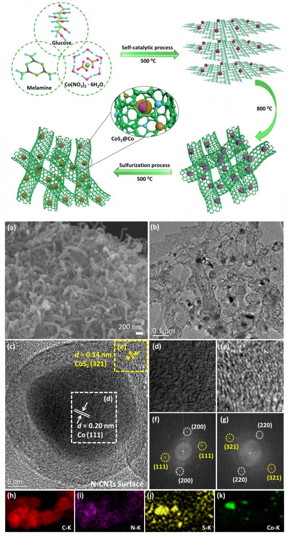Home > Press > S, N co-doped carbon nanotube-encapsulated CoS2@Co: Efficient and stable catalysts for water splitting
 |
| Schematic illustration and physical characterization of S, N co-doped carbon nanotubes encapsulated core-shell (CoS2@Co) nanoparticles. CREDIT ©Science China Press |
Abstract:
Electrochemical water splitting is favorable strategy to produce high-purity H2. The current mainstream catalysts for water electrolysis are precious metals (Pt, RuO2, IrO2), which possess superior catalytic activity, relatively low over-potential and favorable catalytic kinetics, but their high cost and poor cycle stability is still unaffordable. Therefore, it is urgent to develop a new type of hydrogen production catalyst with low cost, high catalytic activity and high stability.
S, N co-doped carbon nanotube-encapsulated CoS2@Co: Efficient and stable catalysts for water splitting
Beijing, China | Posted on September 10th, 2018Due to its low cost, high abundance, and good electrical conductivity, the transition metal-Co and its derivatives have shown great promise in electrocatalysis. However, stability has been a big issue due to their high chemical activities. To address this issue, encapsulation of Co nanoparticles into carbon shell has been proposed as an effective strategy to inherit the high electrocatalytic activity of the transition metal, and further prevent its corrosion from the harsh electrolytic environment. By tuning the metal composition and structure of carbon layers, the catalytic properties of these composites can be regulated.
Recently, Liu Zhao-Qing's group of Guangzhou University reports a bifunctional catalyst, transition metal cobalt ions induced the self-growth of nitrogen doped carbon nanotubes, which are further vulcanized to incorporate sulfur into the carbon nanotubes framework. The obtained materials (S, exhibit excellent HER and OER performance. As cathode and anode, S, can rapidly dissociate water molecules to produce hydrogen and oxygen gases, requiring only 1.633 V to reach a current density of 10 mA cm-2, and a strong stability under various operating currents is also observed.
####
For more information, please click here
Contacts:
Zhao-Qing Liu
Copyright © Science China Press
If you have a comment, please Contact us.Issuers of news releases, not 7th Wave, Inc. or Nanotechnology Now, are solely responsible for the accuracy of the content.
| Related Links |
| Related News Press |
News and information
![]() Researchers develop molecular qubits that communicate at telecom frequencies October 3rd, 2025
Researchers develop molecular qubits that communicate at telecom frequencies October 3rd, 2025
![]() Next-generation quantum communication October 3rd, 2025
Next-generation quantum communication October 3rd, 2025
![]() "Nanoreactor" cage uses visible light for catalytic and ultra-selective cross-cycloadditions October 3rd, 2025
"Nanoreactor" cage uses visible light for catalytic and ultra-selective cross-cycloadditions October 3rd, 2025
Nanotubes/Buckyballs/Fullerenes/Nanorods/Nanostrings
![]() Enhancing power factor of p- and n-type single-walled carbon nanotubes April 25th, 2025
Enhancing power factor of p- and n-type single-walled carbon nanotubes April 25th, 2025
![]() Chainmail-like material could be the future of armor: First 2D mechanically interlocked polymer exhibits exceptional flexibility and strength January 17th, 2025
Chainmail-like material could be the future of armor: First 2D mechanically interlocked polymer exhibits exceptional flexibility and strength January 17th, 2025
![]() Innovative biomimetic superhydrophobic coating combines repair and buffering properties for superior anti-erosion December 13th, 2024
Innovative biomimetic superhydrophobic coating combines repair and buffering properties for superior anti-erosion December 13th, 2024
Discoveries
![]() Researchers develop molecular qubits that communicate at telecom frequencies October 3rd, 2025
Researchers develop molecular qubits that communicate at telecom frequencies October 3rd, 2025
![]() Next-generation quantum communication October 3rd, 2025
Next-generation quantum communication October 3rd, 2025
![]() "Nanoreactor" cage uses visible light for catalytic and ultra-selective cross-cycloadditions October 3rd, 2025
"Nanoreactor" cage uses visible light for catalytic and ultra-selective cross-cycloadditions October 3rd, 2025
Announcements
![]() Rice membrane extracts lithium from brines with greater speed, less waste October 3rd, 2025
Rice membrane extracts lithium from brines with greater speed, less waste October 3rd, 2025
![]() Researchers develop molecular qubits that communicate at telecom frequencies October 3rd, 2025
Researchers develop molecular qubits that communicate at telecom frequencies October 3rd, 2025
![]() Next-generation quantum communication October 3rd, 2025
Next-generation quantum communication October 3rd, 2025
![]() "Nanoreactor" cage uses visible light for catalytic and ultra-selective cross-cycloadditions October 3rd, 2025
"Nanoreactor" cage uses visible light for catalytic and ultra-selective cross-cycloadditions October 3rd, 2025
Energy
![]() Sensors innovations for smart lithium-based batteries: advancements, opportunities, and potential challenges August 8th, 2025
Sensors innovations for smart lithium-based batteries: advancements, opportunities, and potential challenges August 8th, 2025
![]() Simple algorithm paired with standard imaging tool could predict failure in lithium metal batteries August 8th, 2025
Simple algorithm paired with standard imaging tool could predict failure in lithium metal batteries August 8th, 2025
Water
![]() Taking salt out of the water equation October 7th, 2022
Taking salt out of the water equation October 7th, 2022
|
|
||
|
|
||
| The latest news from around the world, FREE | ||
|
|
||
|
|
||
| Premium Products | ||
|
|
||
|
Only the news you want to read!
Learn More |
||
|
|
||
|
Full-service, expert consulting
Learn More |
||
|
|
||








